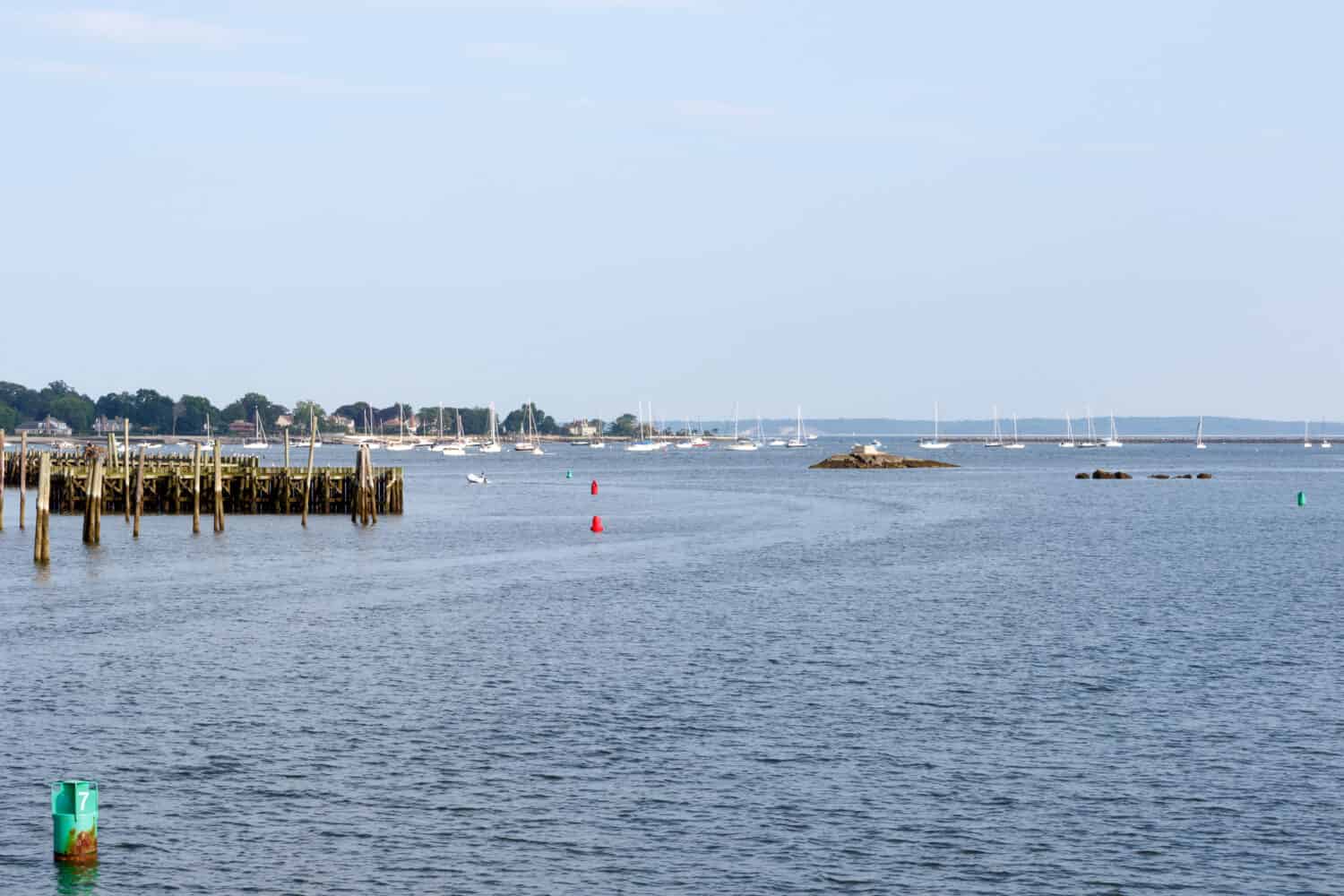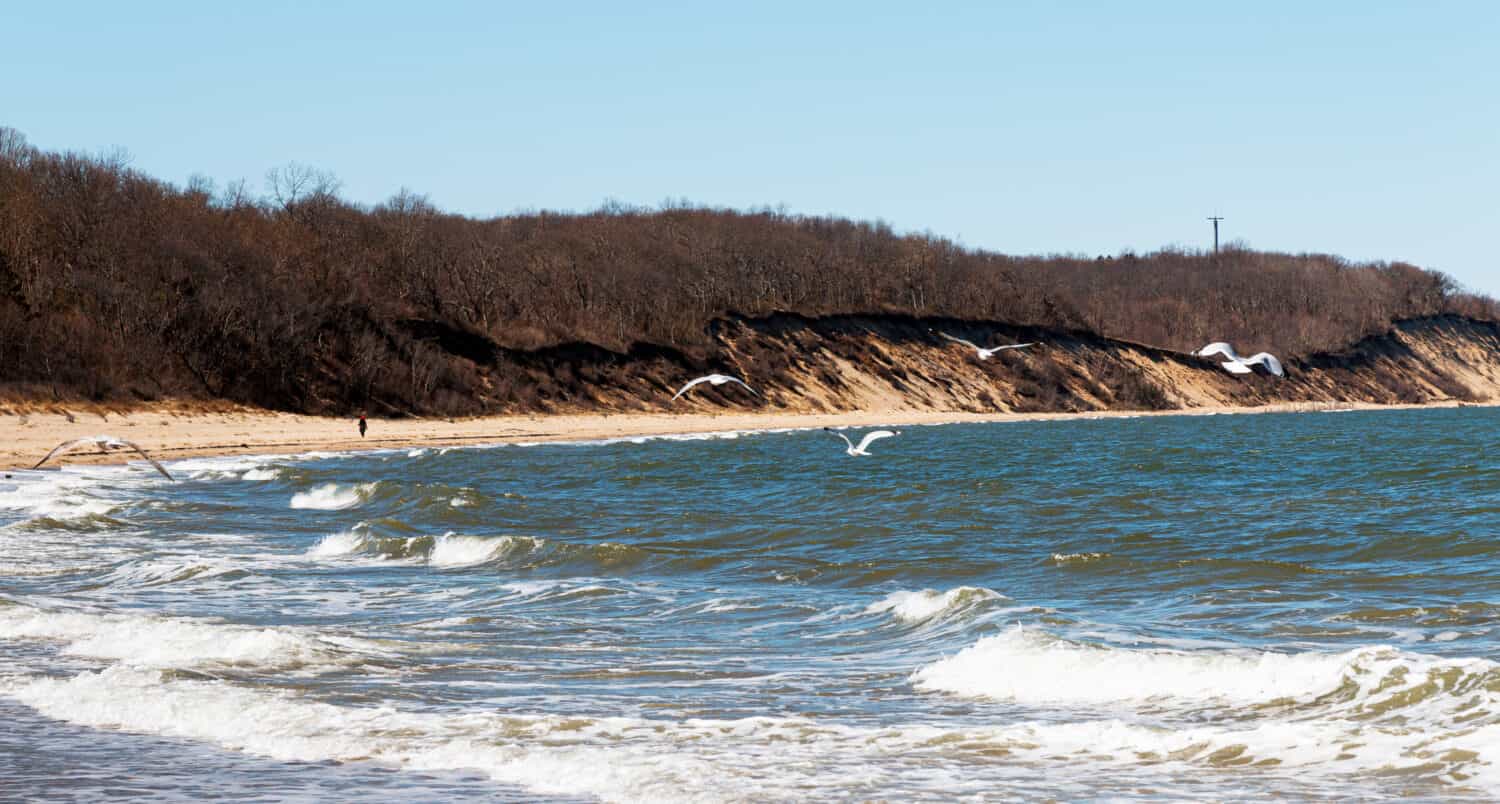The Long Island Sound is a section of water between Long Island and Connecticut. Europeans made their way to that neck of the woods in the early 1600s. However, it is not known to have significance in terms of immigration like Ellis Island. Fascinatingly enough, though, Long Island Sound has a bit of a dark past.
More than 140 shipwrecks are at the bottom of the Long Island Sound. That’s why divers coined it “Wreck Alley,” for its impressive collection of sea vessels at its depths. At the bottom of the sound, you’ll find a what’s-what of sea vessels — from ships to schooners to steamboats and submarines.
Let’s take a look at some of the most famous shipwrecks (and other sea vessel wrecks) located at the bottom of the Long Island Sound. We’ll also add a little history of the Sound and a few fun facts.

Because of the overflow from the rivers after glaciers melted thousands of years ago, the Long Island Sound is both fresh and saltwater.
©Kyle Lee/Shutterstock.com
The Capitol City Wreck
Probably the most infamous shipwreck in the Long Island Sound is the sinking of The Capital City which happened on March 31, 1886. With dense fog as an obstacle, the captain ran into some rocks by Rye Beach and the ship started sinking. The 12 passengers on board loaded onto a boat safely and only the steamship sunk to the bottom of the sound.
Benjamin F. Packard Wreck
Originally a cargo ship that transported equipment and such for decades, the Packard found new life in the 1930s as an attraction for tourists and visitors. The Packard turned into a museum of sorts with exhibitions. There was also a restaurant for those wanting a dining experience by the water. On a fateful night, thunderstorms hit the Packard and unfortunately, she sank into the Sound.
Oscar C. Aiken Wreck
It was common in the 19th century for sea vessels to sink to the bottom of the sea. Oscar C. Aiken, a schooner that transported coal across the Sound, was doing just that on October 25, 1898. Unfortunately, it struck a rock near Plum Island and sank. Luckily, the captain and crew made it to shore safe and sound. Divers recently found the wreckage site of the poor schooner and recovered several artifacts and a lot of coal.
Milford Wreck
This wreck is quite a loss but the recovery is quite a good find! The Milford was a ship that would carry cargo across continents in the 1700s. In her untimely and ultimate voyage, the brig sank carrying a cargo full of French wine. Divers discovered the wreckage and some of the wine. Whether the divers that discovered the wine opened a few bottles to see if it was good, we’ll never know.

A tidal estuary, the Long Island Sound formed over 800,000 years ago.
©Richard A. McGuirk/Shutterstock.com
Steamboat Explosions
The Long Island Sound has the distinction of having not one, but two, steamboat explosions happen in its waters. It was in March 1927, the boiler of the steamboat Oliver Ellsworth exploded. The explosion killed one person and injured several more crew members. Ultimately, the steamship went down to the bottom.
The Lexington was the other steamboat that exploded. It was traversing the Sound headed for Stonington, Connecticut when it caught fire. This was a hugely tragic loss because all 60 passengers and crew died during the sinking in 1840.
Experimental Submarine Wreck
This submarine did not sink by accident. In fact, divers just found the wreckage of the Defender in the spring of 2023. But back in 1907, millionaire Simon Lake built the new-fangled submarine that could traverse on the bottom of waters with wheels. It was meant to be a bid for a US Navy contract, which ultimately did not happen. The submarine was retrofitted for minesweeping, but sadly nothing happened. It was abandoned and the US Army Corps of Engineers destroyed the submarine on purpose, plummeting to the bottom of the Sound indefinitely.
Long Island Sound History

Of the marine life living in the Long Island Sound, there are red crabs, lobsters, grass shrimps, soft-shell crabs, and oysters.
©K Ireland/Shutterstock.com
Many native tribes inhabited the surrounding regions of the Long Island Sound. But it wasn’t until 1614 that the first Europeans sailed into the Sound. Dutch explorer Adriaen Block made his way into the Sound from the East River. Coming into contact with the Sound was quite a shock for Block, as the waters were treacherous. Not only was the passage from the river to the sound atrocious, but the waters in the Sound itself were dangerous. Both stories from natives and Europeans have indeed reflected that, so much so that Europeans coined the Sound “the Devil’s Belt.” Not only that but the reefs around the Sound are called “the Devil’s Stepping Stones.”
Thus began the history of shipwrecks inhabiting the depths of the Sound. The Industrial Revolution did nothing to curb the accidents, either. The Sound was used primarily for manufacturing purposes like textile and fishing, including oyster harvesting. Eventually, as the Environmental Protection Agency became law and more stringent environmental laws were enacted, conservation efforts for the Sound became more prominent to clear up Long Island Sound’s excessive pollution.
Today’s Sound
Today, there is a flourishing marine life that has been the subject of much study. However, climate change is a culprit in endangering the aquatic animals that live in and near the Sound. Oysters eat microplastics, which could endanger them, and also be dangerous for human consumption.
To this day, ferries and commercial ships pass by every day. Fishing is still popular in the Sound and there is still some development like electricity cables that are lined up at the bottom of the sound.
Facts About the Long Island Sound

Several endangered species are found at the Sound including two species of toads, the beige-colored toad, and the Eastern spadefoot; a species of fish, the shortnose
sturgeon
; and a species of turtle, the Diamondback terrapin.
©WoodysPhotos/Shutterstock.com
- The Long Island Sound’s coastline is approximately 600 miles.
- The Sound’s highest depth is 350 feet; its lowest depth is 60 feet.
- Known for its diverse marine habitat, there are 120 species of finfish and 50 species of different aquatic animals.
- The Sound is 21 miles wide and 110 miles wide and it has a whopping 18 trillion gallons of water.
- It borders the states of Rhode Island, Connecticut, and New York.
- The Long Island Sound gets its saltwater from the Atlantic Ocean and it gets 90% of its freshwater from three rivers — the Connecticut, the Housatonic, and the Thames rivers.
Conclusion
And there you have it, Long Island Sound is famous for its shipwrecks trapped at the bottom of its depths. It’s also famous for its history and the Sound has provided for its marine life and humans. Besides being a tidal estuary with marine wildlife, its scary past has shocked divers. They have explored the depths of the Sound with much curiosity, excavating artifacts of the past. Interestingly enough, it almost sounds as if the Sound is haunted, punishing humans for polluting its waters. Nevertheless, the Sound has become an important body of water for Americans living there.
It has provided people with so much for so many years, from transporting people from Connecticut to New York and ensuring oyster harvesting is successful. Divers have discovered amazing artifacts from the sea vehicles at the bottom of the Sound and they will continue to explore what’s down there. New things will emerge that will fascinate sea and history lovers from all over.
Thank you for reading! Have some feedback for us? Contact the AZ Animals editorial team.








